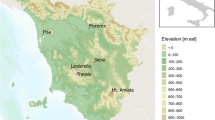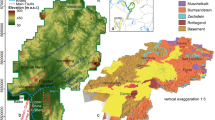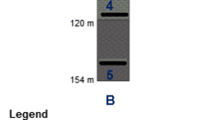Abstract
Estimating depths of buried lava tubes is important for determining the thermal budgets and effusion rates of basaltic volcanic systems. This research used a laboratory experiment scaled to a lava tube system to measure the 3D temperature field surrounding a hot viscous fluid flowing through a buried glass tube while varying conditions such as flow rate and temperature. The depth of the glass tube was changed for different experimental runs. Numerical techniques were applied to model the laboratory experiment. The surface thermal distributions from 166 thermal traverses, constrained to a depth to width ratio of 0.6 to 1.6, were analyzed to empirically derive a depth estimation function using regression techniques. This “Linear Anomaly Surface Transect (LAST)” depth function is a scaleable depth estimation technique which can be solved with thermal imaging data alone. The minimum temperature, maximum temperature and width of a Lorentzian distribution fit to a surface thermal transect, are the only inputs required for the LAST function to estimate the depths of the hot source. The input parameters were then applied to non-laboratory situations including the Kuhio lava tube system in Hawai’i. The LAST function produced depth estimates of ∼ 0.3 m for the Kuhio lava tube in Hawai’i, which did not agree with observations on the ground. This is the result of the complex composition and geometry of an actual lava tube where heat transfer is controlled by more than a simple fluid filling a tube, but also by convection of gasses and fluids in a partially filled passage. Though not effective for lava tubes at this time, the model provides promising results for simple cases applied to engineering and underground coal fires.







Similar content being viewed by others
Abbreviations
- FLIR™:
-
forward looking infrared radiometer
- LAST:
-
linear anomaly surface transect
- HVO:
-
Hawai’i Volcano Observatory
- IR:
-
infrared
- TIR:
-
thermal infrared
- FWHM:
-
full width half max
- FEM:
-
finite element model
References
Berthelote AR (2005) Numerical modeling and remote sensing to determine depths of lava tubes and buried cylindrical hot sources. MS Thesis, University of Alaska Fairbanks
Birch F, Clark H (1940) The thermal conductivity of rocks and its dependence upon temperature and composition. Am J Sci 238:529–558
Calvari S, Pinkerton H (1998) Formation of lava tubes and extensive flow field during the 1991–1993 eruption of Mount Etna. J Geophys Res 103:27291–27301
Calvari S, Pinkerton H (1999) Lava tube morphology on Etna and evidence for lava flow emplacement mechanisms. J Volcanol Geotherm Res 90:263–280
Cassells CJS (1998) Thermal modeling of underground coal fires in northern China. PhD Thesis, University of Dundee
Clauser C, Huenges E (1995) Thermal conductivity of rocks and minerals, rock physics and phase relations—a handbook of physical constants. AGU Ref Shelf 3:105–126
Dragoni M (1989) A dynamical model of lava flows cooling by radiation. Bull Volcanol 51:88–95
Dragoni M, Piombo A, Tallarico A (1995) A model for the formation of lava tubes by roofing over a channel. J Geophys Res 100:5435–8448
Dunn JC, Carrigan CR, Wemple RP (1983) Heat transfer in magma in situ. Science 222:1231–1233
Flynn LP, Mouginis-Mark PJ, Horton KA (1994) Distribution of thermal areas on an active lava flow field: Landsat observations of Kilauea, Hawaii, July 1991. Bull Volcanol 56:284–296
Greene GW, Moxham RM, Harvey AH (1969) Aerial infrared surveys and Borehole temperature measurements of coal mine fires in Pennsylvania. In: Proceedings of the sixth international symposium of remote sensing environment, Michigan, 13–16 October 1969. Michigan Institute of Science and Technology, University of Michigan, Ann Arbor, MI, pp 517–525
Harris AJL, Rowland SK (2001) FLOWGO: a kinematic therm-rheological model for lava flowing in a channel. Bull Volcanol 63:20–40
Harris AJL, Flynn LP, Keszthelyi L, Mouginis-Mark PJ, Rowland SK, Resing JA (1998) Calculation of lava effusion rates from Landsat TM data. Bull Volcanol 60:52–71
Heliker C, Mattox TN (2003) The first two decades of the Pu’u ‘O’o-Kupaianaha eruption: chronology and selected bibliography. US Geol Surv Prof Pap 1676:1–28
Heliker C, Swanson DA, Takahashi TJ (2003) The Pu‘u ‘\( \overline{{\text{O}}} \)‘\( \overline{{\text{o}}} \) -Kupaianaha eruption of Kilauea Volcano, Hawai’i: the first 20 years. US Geol Surv Prof Pap 1676:77
Hon KA, Kauahikaua J, Denlinger R, Mackay K (1994) Emplacement and inflation of pahoehoe sheet flows: Observations and measurements of active lava flows on Kilauea Volcano, Hawai’i. Geol Soc Amer Bull 106:351–370
Incropera FP, DeWitt DP (2002) Fundamentals of heat and mass transfer. Fifth Edition, Wiley, New York, pp 465–570
Ishihara K, Iguchi M, Kamo (1990) Numerical simulations of lava flows on some volcanoes in Japan. In: Fink JH (ed) Lava flows and domes. Springer, Berlin Heidelberg New York, pp 174–207
Kauahikaua J, Cashman KV, Mattox TN, Heliker CC, Hon KA, Mangan MT, Thornber CR (1998) Observations on basaltic lava streams in tubes from Kilauea Volcano, island of Hawai’i. J Geophys Res 103:27303–27323
Keszthelyi L (1995) A preliminary thermal budget for lava tubes on the earth and planets. J Geophys Res 100:20411–20420
Keszthelyi L, Denlinger R (1996) The initial cooling of pahoehoe flow lobes. Bull Volcanol 58:5–18
Keszthelyi L, Harris AJL, Dehn J (2003) Observations of the effect of wind on the cooling of active lava flows. Geophys Res Lett 30: DOI 10.1029/2003GL017994
Manley CR (1992) Extended cooling and viscous flow of large, hot rhyolite lavas: implications of numerical modeling results. J Volcanol Geotherm Res 53:27–46
Mattox TN, Heliker CC, Kauahikaua J, Hon KA (1993) Development of the 1990 Kalapana Flow Field, Kilauea Volcano, Hawai’i. Bull Volcanol 55:407–413
Mukherjee TK, Bandhopadhyay TK, Pande SK (1991) Detection and delineation of depth of subsurface coalmine fires based on an airborne multispectral scanner survey in part of Jharia Coalfield, India. Photogramm Eng Remote Sensing 57:1203–1207
Murase T, McBirney AR (1973) Properties of some common igneous rocks and their melts at high temperatures. Geol Soc Amer Bull 84:3563–3592
Neri A (1998) A local heat transfer analysis of lava cooling in the atmosphere: application to thermal diffusion-dominated lava flows. J Volcanol Geotherm Res 81:215–243
Panigrahi DC, Singh MK, Singh C (1995) Predictions of depth of mine fire from the surface by using thermal infrared measurement. In: Proceedings of the national seminar on mine fires, Varanasi, India, 24th–25th February 1995. Banaras Hindu University, Varanasi, pp 122–134
Patrick MR, Dehn J, Dean K (2004) Numerical modeling of lava flow cooling applied to the 1997 Okmok eruption: approach and analysis. J Geophys Res 109: DOI 10.1029/2003JB002537
Peck DL (1978) Cooling and vesiculation of Alae Lava Lake , Hawaii. US Geol Surv Prof Pap 935-B:1–73
Peck DL, Hamilton MS, Shaw HR (1977) Numerical analysis of lava lake cooling models: part II, application to Alae Lava Lake, Hawai’i. Am J Science 277:415–437
Peterson DW, Holcomb RT, Tilling RI, Christiansen RL (1994) Development of lava tubes in the light of observations at Mauna Ulu, Kilauea Volcano, Hawai’i. Bull Volcanol 56:343–360
Prakash A, Sastry RJS, Gupta RP, Saraf AK (1995) Estimating the depth of buried hot features from thermal IR remote sensing data: a conceptual approach. Int J Remote Sens 16:2503–2510
Reddy JN (1993) An Introduction to the finite element method. McGraw-Hill, New York
Robertson EC (1988) Thermal properties of rocks. US Geol Surv Open-File Rep:88–441
Rosema A, Guan H, Veld H, Vekerdy Z, Ten Katen AM, Prakash A (1999) Manual of coal fire detection and monitoring, Report of the project ‘development and implementation of a coal fire monitoring and fighting system in China’. In: Netherlands Institute of Applied Geoscience report NITG 99-221-C:80
Rowland SK, Walker GPL (1987) Toothpaste lava: characteristics and origin of a lava structural type transitional between pahoehoe and àà. Bull Volcanol 49:631–641
Rowland SK, Walker GPL (1990) Pahoehoe and àà in Hawai’i: volumetric flow rate controls the lava structure. Bull Volcanol 52:615–628
Sakimoto SEH, Zuber MT (1998) Flow and convective cooling in lava tubes. J Geophys Res 103:27465–27487
Shaw HR, Hamilton MS, Peck DL (1977) Numerical analysis of lava lake cooling models: part I, description of the method. Am J Sci 277:384–414
Slavecki RJ (1964) Detection and location of subsurface coalfires. In: Proceedings of the third international symposium on remote sensing of environment. Michigan Institute of Science and Technology, University of Michigan, pp 537–547
Taylor JR (1997) An introduction to error analysis: the study of uncertainties in physical measurements. Second Edition, University Science Books, California, pp 73–77
Touloukian YS, Judd WR, Roy RF (eds) (1989) Physical properties of rocks and minerals. Hemisphere Publishing Company, New York
Turcotte DL, Schubert G (2001) Geodynamics. Second Edition, Cambridge University Press, Cambridge, 528 pages
Witter JB, Harris AJL (2007) Field measurements of heat loss from skylights and lava tube systems. J Geophys Res 112:B01203. DOI 10.1029/2005JB003800
Worster MG, Huppert HE, Sparks RSJ (1993) The crystallization of lava lakes. J Geophys Res 98:15891–15901
Acknowledgements
We would like to thank the reviewers, Rob Wright and Massimiliano Favalli. We wish to thank NASA’s Earth System Science Education for the 21st Century program and the Alaska Space Grant Program for funding parts of this research. The work was made possible through collaborations with the University of Hawai’i. We gratefully acknowledge the Alaska Volcano Observatory, Andy Harris, Rob Wright and the Hawai’i Volcano Observatory for assistance with field data collection. Thanks to Paul Layer and Douglas Goering for their input and critical comments.
Author information
Authors and Affiliations
Corresponding author
Additional information
Editorial responsibility: A. Harris
Rights and permissions
About this article
Cite this article
Berthelote, A.R., Prakash, A. & Dehn, J. An empirical function to estimate the depths of linear hot sources: Laboratory modeling and field measurements of lava tubes. Bull Volcanol 70, 813–824 (2008). https://doi.org/10.1007/s00445-007-0171-0
Received:
Accepted:
Published:
Issue Date:
DOI: https://doi.org/10.1007/s00445-007-0171-0




